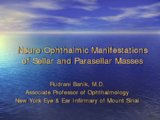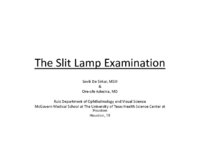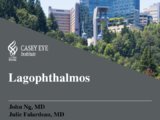Collection of materials relating to neuro-ophthalmology as part of the Neuro-Ophthalmology Virtual Education Library.
NOVEL: https://novel.utah.edu/
TO
- NOVEL717
| Title | Creator | Description | Subject | ||
|---|---|---|---|---|---|
| 176 |
 |
Neuro-Ophthalmic Manifestations of Sellar and Parasellar Masses | Rudrani Banik, MD | Neuroanatomy of the Chiasm. | Parasellar Masses |
| 177 |
 |
The Slit Lamp Examination | Sovik De Sirkar, MSIII; Ore-ofe Adesina, MD | This is a comprehensive description of the slit lamp examination. | Slit Lamp |
| 178 |
 |
Ectropion and Entropion | Julie Falardeau, MD; Eric A. Steele, MD | This is a brief PowerPoint presentation describing 2 common disorders of eyelid position: ectropion and entropion. We provide the classification of these 2 disorders as well as clinical photographs | Ectropion; Entropion; Eyelid |
| 179 |
 |
Lagophthalmos | Julie Falardeau, MD; John D. Ng, MD | This is a brief PowerPoint presentation for the NANOS Examination Curriculum describing how to evaluate lagophthalmos, discussing the main causes of lagophthalmos and demonstrating few clinical examples. | Lagophthalmos; Eyelid |
| 180 |
 |
Tonometry | Ore-ofe Adesina, MD | Presentation covering the measurement of intraocular pressure, Tonometry. Covers indentation, applantation and electronic tonometry. | Tonometry; Intraocular Pressure |
| 181 |
 |
Optic Disc Drusen (Portuguese) | NANOS | Optic disc drusen are abnormal deposits of protein-like material in the optic disc - the front part of the optic nerve. | Optic Disc Drusen; Patient Brochure |
| 182 |
 |
Pituitary Tumor (Portuguese) | NANOS | Pituitary tumors are benign (non-cancerous) overgrowth of cells that make up the pituitary gland (the master gland that regulates other glands in the body). | Pituitary Tumor; Patient Brochure |
| 183 |
 |
Optic Neuritis (Portuguese) | NANOS | In the most common form of optic neuritis, the optic nerve has been attacked by the body's overactive immune system and results in decreased vision. | Optic Neuritis; Patient Brochure |
| 184 |
 |
Transient Visual Loss (Portuguese) | NANOS | About transient visual loss. | Transient Visual Loss; Patient Brochure |
| 185 |
 |
Photophobia (Portuguese) | NANOS | The symptoms of light sensitivity are: an uncomfortable sense of brightness, squinting, frequent blinking, and redness of the eye (especially if the eye is dry). Involuntary eye closure and excessive blinking is seen with blepharospasm. Individuals will tend to seclude themselves in darkness. | Photophobia; Patient Brochure |
| 186 |
 |
Myasthenia Gravis (Portuguese) | NANOS | This is an autoimmune condition where the body's immune system has damaged receptors on your muscles and can result in double vision or drooping lid. | Myesthenia Gravis; Patient Brochure |
| 187 |
 |
Progressive Supranuclear Palsy (Portuguese) | NANOS | About Progressive Supranuclear Palsy. | Progressive Supranuclear Palsy; Patient Brochure |
| 188 |
 |
Optic Nerve Sheath Meningioma (Portuguese) | NANOS | About optic nerve sheath meningioma. | Optic Nerve Sheath Meningioma; Patient Brochure |
| 189 |
 |
Anterior Ischemic Optic Neuropathy (Portuguese) | NANOS | Loss of blood supply to the optic nerve results in diminished visual acuity. | Anterior Ischemic Optic Neuropathy; Patient Brochure |
| 190 |
 |
Anisocoria (Portuguese) | NANOS | Pupil in the right eye and left eye are not the same size. | Anisocoria; Patient Brochure |
| 191 |
 |
Blepharoespasm (Portuguese) | NANOS | Uncontrolled blinking, squeezing, and eyelid closure that occurs in both eyes without an apparent environmental cause. | Blepharospasm; Patient Brochure |
| 192 |
 |
Dry Eye Syndrome (Portuguese) | NANOS | People with abnormalities of the tear film are diagnosed with "dry eyes", but some patients with "dry eyes" may not feel that their eyes are "dry". Itching, burning, a scratchy sensation, a sensation that there is sand or grit in the eye, or intermittent blurring of the vision can all be symptoms of... | Dry Eye Syndrome; Patient Brochure |
| 193 |
 |
Homonymous Hemianopia (Portuguese) | NANOS | This refers to an absence of vision towards one side of the visual world in each eye. The damage that caused this problem is in the brain and not in the eyes. | Homonymous Hemianopia; Patient Brochure |
| 194 |
 |
Microvascular Nerve Palsy (Portuguese) | NANOS | Microvascular cranial nerve palsy is one of the most common causes of double vision in the older poulation. They are often referred to as "diabetic" palsies. They will resolve without leaving any double vision. | Microvascular Nerve Palsy; Patient Brochure |
| 195 |
 |
Migraine Enxaqueca (Portuguese) | NANOS | Headache on one or both sides of the brain, and may include symptoms of nausea, vomiting, and sensitivity to light. | Migraine; Patient Brochure |
| 196 |
 |
Meniere Disease (Portuguese) | NANOS | About Meniere disease. | Meniere Disease; Patient Brochure |
| 197 |
 |
Hemifacial Spasm (Portuguese) | NANOS | Involuntary contractions, called "spasms," of the muscles on one side of the face. The affected side of the face seems to "scrunch up" while the other side of the face remains normal. | Hemifacial Spasm; Patient Brochure |
| 198 |
 |
Eyelid Myokymia (Portuguese) | NANOS | Excessive or anomalous eyelid closure. | Eyelid Myokymia; Patient Brochure |
| 199 |
 |
Idiopatic Intracranial Hypertension (Portuguese) | NANOS | Raised intracranial pressure. | Idiopathic Intracranial Hypertension; Patient Brochure |
| 200 |
 |
Optochiasmal Tuberculoma | Jeanie Paik, MD; Rudrani Banik, MD | PowerPoint of case of chiasmal tuberculoma causing bitemporal defect in patient with tuberculosis on RIPE treatment; case history, differential diagnosis and treatment discussed. | Chiasmal Disorder; Chiasmal Tuberculoma; Bitemporal Visual Field Defect; Ethambutol Optic Neuropathy |
